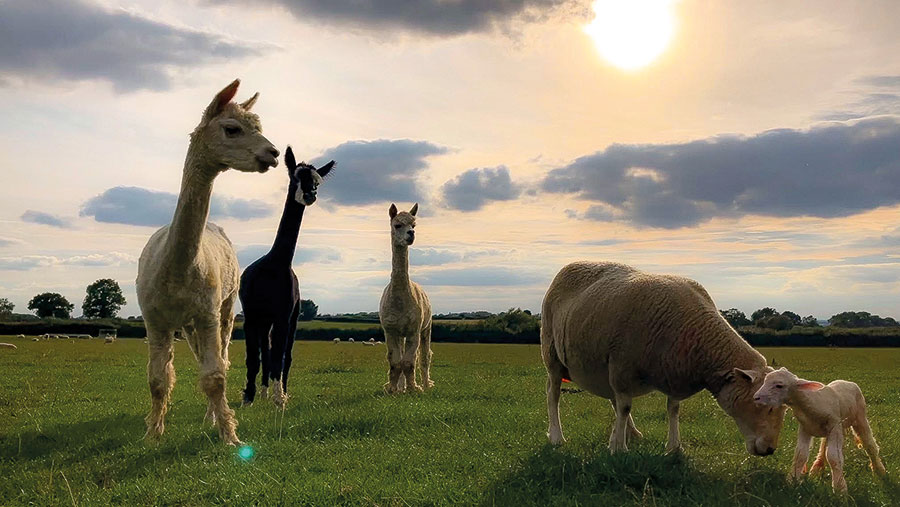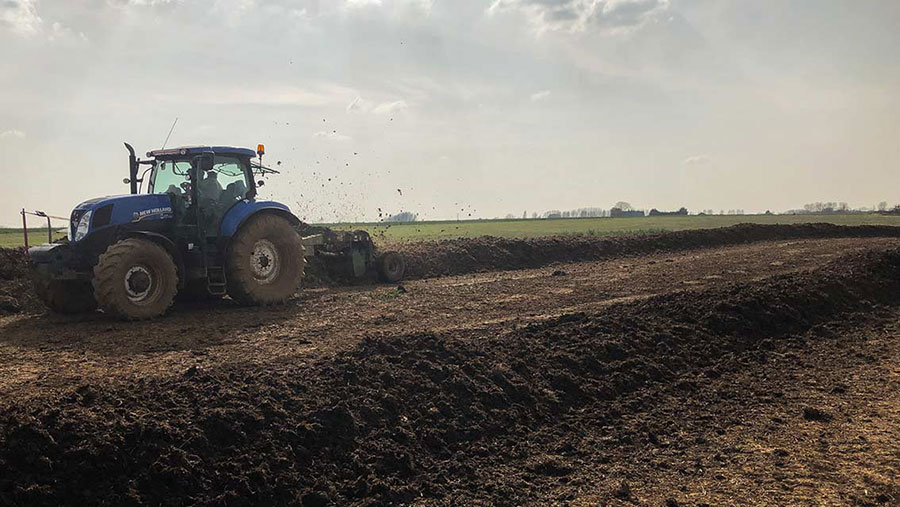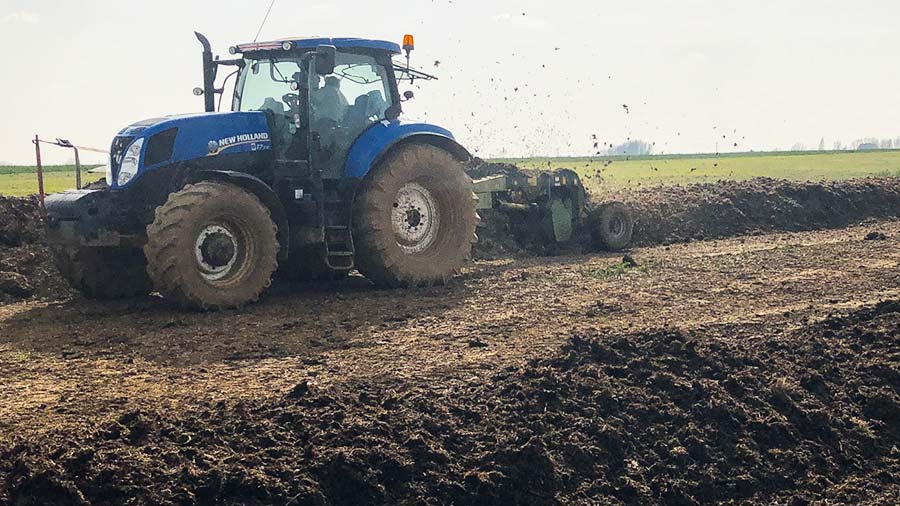3 regenerative initiatives build resilience on family farm
 © Richard Tustian
© Richard Tustian Since returning to the family partnership to join his father, Robert, last autumn, fourth-generation farmer Richard Tustian has implemented some key initiatives.
They form part of the farm’s transition to a regenerative system to help make it more resilient.
He was originally self-employed, working on a range of different farms and, latterly, spent four years employed as a shepherd on the Blenheim estate.
This experience fed into the initiatives he brought into the family business:
- buying a September-lambing flock of Dorset ewes
- composting cattle muck
- grazing sheep on winter cereals
See also: 7 farmer tips on moving to regenerative farming
“Our overall goal is for the business to still be going in 30 years’ time, with the opportunity for the next generation to carry it on,” says Mr Tustian.
Farm facts
- 10 ha (25 acres) of herbal leys
- 40ha (99 acres) of permanent pasture
- 150ha (370 acres) of arable, including oilseed rape, beans, barley and wheat
- 100 Dorset ewes
- 200 Exlana ewes
- 20 suckler cows, rearing all progen
Grazing and forage planning
Livestock are at the heart of grazing and forage planning – the cropping system is designed to fit their requirements. The focus is to improve soil structure, microbiology and water-holding capacity.
The whole of the arable area has cover crops planted, which also provides winter grazing.
The farmed area totals 200ha (494 acres) and is a mixture of owned and rented land. This consists of 40ha (99 acres) of permanent pasture, 10ha (25 acres) of herbal leys, and the rest arable.
Cropping has shifted from continuous wheat to include oilseed rape, winter and spring barley, winter beans and winter wheat.
Furthermore, fertiliser requirements have been significantly reduced, to 30kg N/ha on cereals and 50kg N/ha on oilseed rape.
He attributes this to a combination of livestock integration, effective use of cattle muck and the introduction of cover and break crops to help fix soil nutrients.
Introducing sheep
Mr Tustian bought 100 Dorset-cross ewes in a farm dispersal sale in spring 2022. The aim is to lamb these in September each year.
He chose Dorsets because they can lamb at any time of year and are well-suited to a forage-only diet.
He hopes lambs can be finished on cover crops between February and April and will be ready for sale for the Easter market when there is typically an uplift in prices.
It also means lambs will be away before the summer when the arable workload is highest. The previous flock of North Country Mules was sold in August.
The Dorsets were tupped in mid-April and lambed outdoors in the first half of September on clover and rape stubble.
The clover was originally planted with buckwheat as a companion crop to help minimise flea beetle damage in the rape.
It produced an understorey that lasted through to harvest and provided welcome forage: the Dorset ewes grazed on a 6ha (15-acre) area ahead of lambing and another 20ha (50-acre) area was used to finish some lambs.
Mr Tustian grazes three castrated male Alpacas with the sheep to help protect the sheep against foxes.

© Richard Tustian
Lambing performance
The flock achieved a lambing percentage of 201%, with 82 ewes lambing out of the original 99. No ewes were turned out with more than two lambs each to avoid overworking them.
They found 17 empty ewes at scanning, all of which got in-lamb during the second cycle. Mr Tustian believes they may have lost the lambs following shearing in the first week of June.
Therefore, he is considering delaying shearing by four to six weeks to avoid unsettling them in early pregnancy, or shearing much earlier – but it might be tricky for the ram to mate sheared ewes.
This has, in part, prompted him to buy 200 Exlana ewe lambs. They carry some genetics that mean they might cycle all year round and the plan is to mate them in April when they are 12 months old.
“Any ewes that take will join the Dorset flock and lamb in September, increasing flock numbers,” Mr Tustian explains.
“The back-up plan is that those that don’t get in-lamb can be tupped again in the autumn to lamb in spring 2024.” But by 2025, the aim is to have the whole flock lambing in September.
Grazing options
The sheep graze herbal leys containing 15-20 different species, the majority of them legumes, plus some cocksfoot. Weaned lambs from the previous Mule flock grazed the leys in April this year, followed by cattle.
Remaining store lambs from the Mule flock will now graze the rape stubble and remaining clover over winter, ahead of planting barley next spring.
Meanwhile, ewes and lambs are being moved onto the herbal leys, grazing in temporary paddocks. Fences are moved every five days or so, to allow sward regeneration.
The aim is to have all livestock off the permanent pasture by the end of November, until the beginning of April. They will instead graze herbal leys, winter cover crops or cereals.

© Richard Tustian
Barley trial: grazing and compost
This year, grazing sheep were trialled on barley in February and March. Grazed and ungrazed areas of the field were compared. Composted cattle muck was spread on the barley in April, once the sheep had moved.
One area received compost only, one was grazed only, another received compost and was grazed, and the final one had neither.
“The barley held up well, with no positive or negative effect of grazing on the crop yields when it was harvested in early July,” Mr Tustian reports.
“However, it gives us additional options for grazing in February, allowing grassland to get a good start.” In addition, no growth regulator, fungicides or insecticides were needed on the barley.
“While barley yields are not particularly high, at around 6-6.5t/ha, the upshot is that we have reduced inputs without a negative effect on barley yield,” he says.
Composting cattle muck
Mr Tustian started mucking out cattle sheds on 1 January this year and put the muck into windrows on a 0.4ha (1 acre) area of land.
He modified a mower conditioner to turn it once a week for four weeks and added some woodchip to help encourage fungal development.
After three months, it was ready to apply to the cereals, with microbiological tests showing he had achieved a fungal-dominated compost. This is good for soil development and function.
Although this is not full composting, it does allow the initial breakdown of the muck.
There are presently 600 tonnes of compost in storage, including some from other local farmers, and it will be applied to all cereals next spring.

© Richard Tustian
Future
The next step is to transition the breed of the farm’s 20 dairy-cross suckler cows. They are already successfully grazing on herbal leys, with no mastitis problems this year.
The Tustians plan to breed them with their own Simmental-crosses to bring them a step closer to a beef breed, which is better suited to a grass-based system.
